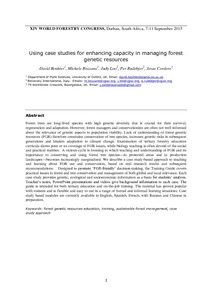Towards wellbeing in forest communities: a source book for local government
Governments in many countries are decentralising to give more control over decision making and budgets to local administrations. One expectation of this change is that local governments will more effectively and efficiently respond to the poorest citizens in their jurisdictions. Decentralisation is especially significant to forest communities, which have historically benefited little from government services and poverty reduction programmes because of their physical isolation and social marginalisation.
Towards wellbeing: monitoring poverty in Kutai Barat, Indonesia
Poverty is a persistent problem throughout Indonesia. Seven years after decentralisation began there is little improvement in the wellbeing of rural people. Local governments have received new opportunities and responsibilities for development, but few districts have the necessary capacity and experience to effectively reduce poverty. This report provides a portrait of household poverty and wellbeing in Kutai Barat, a district that was only established in 1999.
Towards wellbeing: monitoring poverty in Malinau, Indonesia
Poverty is a persistent problem throughout Indonesia. With decentralization, local governments had a new direct role in alleviating poverty and local wellbeing. At the same time they could do so in accordance with local realities and development needs. Yet, there is little improvement in the wellbeing of rural people. Local governments may lack the necessary capacity and experience to reduce poverty effectively. This report shows how a local specific monitoring system can be developed and applied.
The wealth of the dry forests: can sound forest management contribute to the millennium development goals in Sub-Saharan Africa?
Dry forests in Sub-Saharan Africa (SSA) cover approximately 43% of the continent. They are inhabited by nearly 236 million people, many of these the poorest in the world. A majority of the population of these regions is dependent on traditional energy sources (i.e., firewood, charcoal and organic wastes), subsistence farming, generally free-ranging livestock, and products harvested from the dry forests. Growing pressure on dry forest resources to meet human and socioeconomic development needs mean that dry forests are increasingly being utilised unsustainably.
Understanding conflict in the co-management of forests: the case of Bulungan Research Forest
The paper describes underlying causes of conflicts between local people in Bulungan Research Forest (BRF), Indonesia with coal-mining and logging companies. Results show that conflict between local people and mining companies was triggered by the fact that mining operation caused water and air pollution and soil degradation. Another cause for such a conflict was the compensatory facilities (e.g. clean water, electricity, compensation fee, etc.) provided by the companies to local people were often delayed or unsatisfactory.
Understanding patterns of resource use and consumption: a prelude to co-management
For co-management of conservation areas to be effective, detailed information on local people's use of natural resources is essential. One method to obtain some of that information, a household record keeping study, is given. It is simple to implement and analyse, and provides useful, quantitative data on resource use and income levels. The method and present data derived from three studies of Melayu and Iban communities in and around the Danau Sentarum Wildlife Reserve in West Kalimantan, Indonesia, are described.
Tropical secondary forests in Nepal and their importance to local people
Most forests in tropical Nepal are secondary, resulting largely from episodes of large-scale timber harvesting in the past along with accumulated small scale extraction of timber and non-timber forest products by local people over centuries. Currently in the forest depleted stage, remaining tropical secondary forests are still very important for fulfilling the subsistence and economic needs of local people, as well as for biodiversity conservation, groundwater recharge, and the protection of lowland agriculture from landslides and floods.
Upaya-upaya baru membentuk interaksi pemerintah dan masyarakat
Using case studies for enhancing capacity in managing forest genetic resources
Forest trees are long-lived species with high genetic diversity that is crucial for their survival,
regeneration and adaptation. However, forest managers and conservationists are often not well informed
Using dendro-ecology to determine growth rates and timber yields from Swietenia macrophylla and Cedrela odorata in community managed forest concesssions in Guatamala
Where are the poor and where are the trees?: targeting of poverty reduction and forest conservation in Vietnam (Vietnamese)
This paper highlights the spatial linkages of forest quality with poverty incidence and poverty density in Vietnam. Most of the Vietnamese poor live in densely populated river deltas and cities while remote upland areas have the highest poverty incidences, gaps, and severities. Forests of high local and global value are located in areas where relatively few poor people live, but where the incidence, gap, and severity of poverty are strongest, and where the livelihood strategies are based on agricultural and forest activities.



